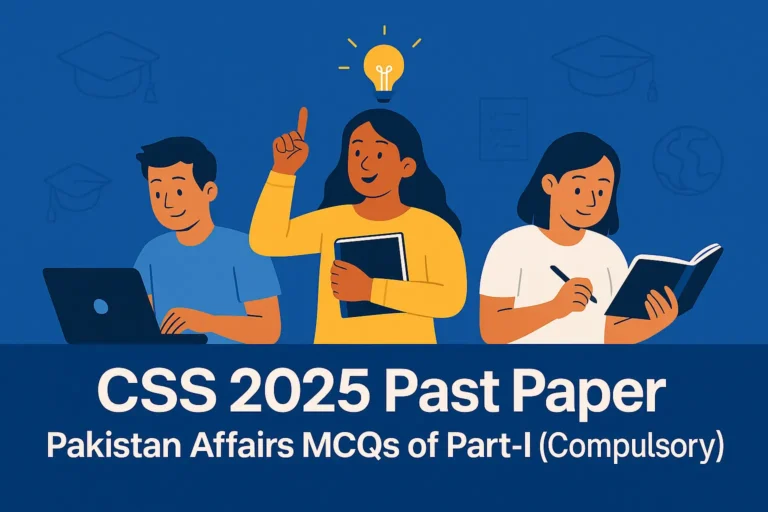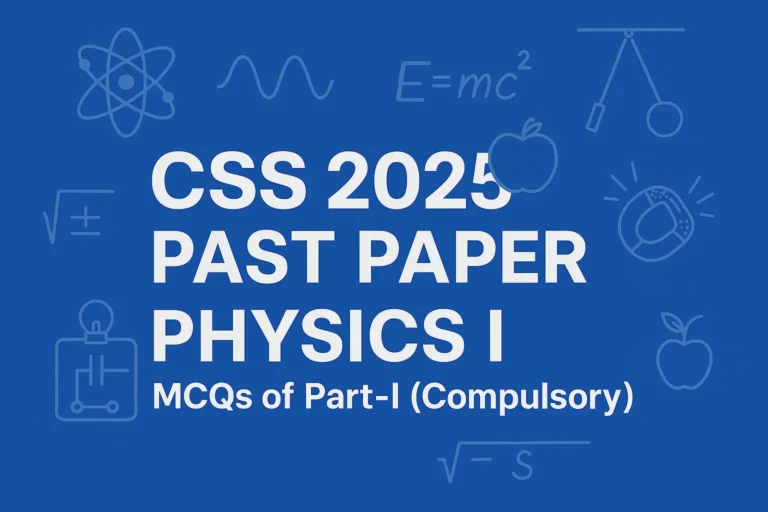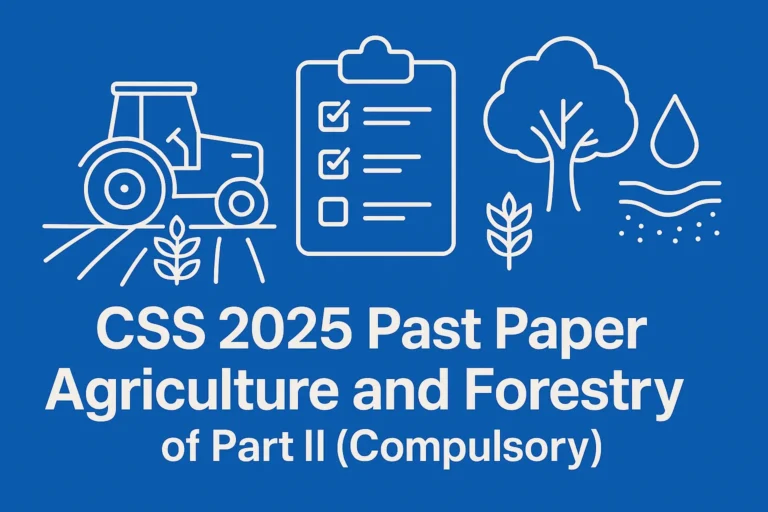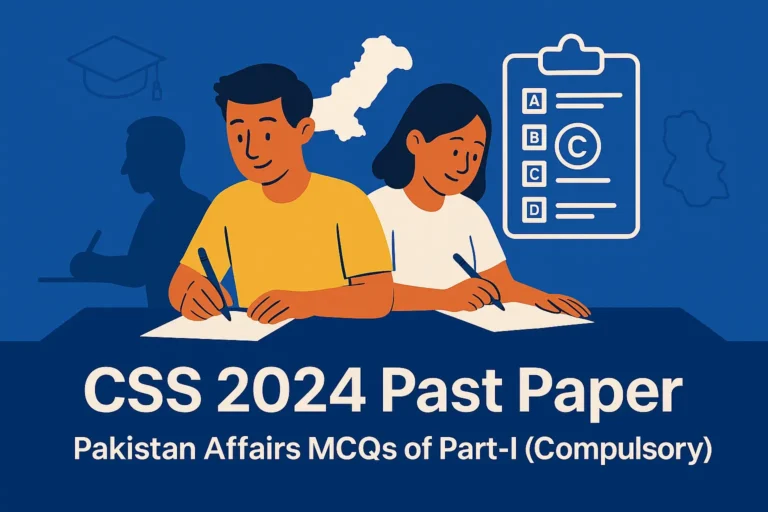CSS 2018 Solved Past Paper – Journalism & Mass Communication Part-II (Compulsory)
Below is the solution to PART-II (COMPULSORY) of the CSS 2018 Journalism & Mass Communication Paper.
Question 2
Traditionally, communication theory as a distinct area of media studies has transited through minimum four eras of its development. Explain these eras and their specific characteristics by categorizing the communication theories associated with them.
Introduction
Communication theory has developed over time through different eras. Each era brought new ideas and approaches based on the situation of that time. From simple transmission models to complex cultural and critical theories, communication has evolved a lot. These eras help us understand how communication changed with society, politics, and technology.
The Classical Era (1920s–1940s)
This was the beginning of formal communication theories. This era focused on how media messages are sent and received. It was very linear and mechanical.
Main Characteristics:
- Communication seen as one-way process (sender → message → receiver).
- Focused on effects of mass media on audience.
- Influenced by World War propaganda.
Key Theories:
- Hypodermic Needle Theory / Magic Bullet Theory: This theory says media has powerful and direct effect on people. Whatever media says, people believe it like an injection.
- Lasswell’s Model (1948): “Who says what in which channel to whom with what effect?” – a basic structure for studying media.
The Empirical/Scientific Era (1940s–1960s)
This era focused more on research and evidence. Scholars started doing surveys, experiments, and audience studies.
Main Characteristics:
- Communication seen as scientific and measurable.
- Media not as powerful as thought before.
- Audience is active and selective.
Key Theories:
- Two-Step Flow Theory (Lazarsfeld & Katz): Media affects opinion leaders first, and then they influence others.
- Uses and Gratifications Theory: People use media to satisfy their own needs (like info, entertainment, social interaction).
- Shannon and Weaver Model: Introduced idea of “noise” in communication and feedback loop.
The Critical/Cultural Era (1960s–1980s)
This period brought criticism of media power and capitalism. Focus shifted from effects to meanings and ideologies in media content.
Main Characteristics:
- Media as a tool of ideological control.
- Audience seen as resistant and creative, not passive.
- Concerned with culture, identity, and power.
Key Theories:
- Frankfurt School (Adorno, Horkheimer): Media creates “false needs” in people to support capitalism.
- Stuart Hall’s Encoding/Decoding Model: Media sends messages (encoding) but audience can interpret (decode) them differently.
- Agenda Setting Theory (McCombs & Shaw): Media may not tell people what to think, but it tells them what to think about.
The Contemporary/Modern Era (1980s–present)
This era is based on globalization, technology, and digital media. Communication now includes internet, social media, and participatory culture.
Main Characteristics:
- Interactive communication (not one-way anymore).
- Rise of new media and citizen journalism.
- Focus on identity, globalization, media ethics.
Key Theories:
- Spiral of Silence Theory (Noelle-Neumann): People stay silent if they think their opinion is unpopular.
- Cultivation Theory (Gerbner): Long-term exposure to media shapes people’s view of reality.
- Diffusion of Innovations (Everett Rogers): Explains how new ideas or tech spread through society.
Conclusion
Each era of communication theory reflects the world’s changes — war, science, technology, culture, and now digital media. From simple sender-receiver models to critical thinking about media power, communication theory keeps evolving. Knowing these eras helps students understand both the history and the future of journalism and mass communication.
Question 3
Elizabeth Noelle-Neumann propounded the spiral of Silence Theory in 1974 while examining public opinion as a form of social control, which later emerged as a milestone in public opinion formation research. Discuss it in detail by drawing model of the theory.
Introduction
The Spiral of Silence Theory was introduced by Elisabeth Noelle-Neumann in 1974. She was a German political scientist and media researcher. This theory explains how public opinion is formed and why people often stay silent, especially when they think their opinion is different from the majority.
It is called “spiral of silence” because people’s silence increases like a spiral — when they feel isolated, they don’t speak up, and that silence makes others feel more isolated too.
Main Concepts of the Theory
1. Fear of Isolation
People don’t want to be socially isolated. So, if they feel their opinion is in the minority, they stay silent.
2. Quasi-Statistical Sense
This is like a social radar. People can sense what most others think, even without being told.
3. Public Opinion as Social Control
The theory sees public opinion as a pressure tool. People follow the dominant opinion because they fear rejection or criticism.
4. Role of Mass Media
Media plays a huge role in showing which opinion is popular and which is not. Media highlights the majority view, making the minority opinion look weaker.
Diagram / Model of Spiral of Silence
Here’s a simple version of the model:

The spiral keeps growing unless someone breaks the silence.
Example (To Support Understanding)
Let’s say in a classroom, most students support online exams. A few don’t agree, but they stay quiet because they think no one will support them. So, their voice never comes out, and the teacher thinks everyone supports online exams.
This is exactly how the spiral of silence works.
Importance of the Theory
- Explains Media Influence: Shows how media shapes public opinion without forcing anyone.
- Helps in Political Science: Useful in elections and political campaigns to study voter behavior.
- Applies to Social Media: In today’s world, people are still afraid to post unpopular opinions online.
Criticism of the Theory
- Underestimates Brave People: Not everyone stays silent. Some people speak up even when they are alone.
- Over-focus on Fear: There are many other reasons why people stay quiet (like time, mood, etc.).
- Cultural Differences: In some cultures, people are more expressive and less afraid of isolation.
Conclusion
The Spiral of Silence Theory is a powerful explanation of how opinions are shaped in society. It shows that silence can grow like a spiral and that media plays a key role in it. Even in today’s digital age, this theory is still relevant. Understanding it helps us see why some voices are heard more than others — and why it’s important to give space for every opinion.
Question 4
In international and global communication context, communication and culture are strongly associated with each other. Discuss the nexus in the light of Marxist and Gramsci approaches.
Introduction
In today’s globalized world, communication and culture are deeply connected. Media is not just sharing news or information, but also spreading values, beliefs, and traditions. The way countries communicate in international or global context is often influenced by cultural factors.
Two major thinkers — Karl Marx and Antonio Gramsci — explained how media and communication are linked with power, control, and culture. Their ideas help us understand how global media can shape or even dominate other cultures.
Understanding the Nexus: Communication and Culture
- Culture means shared ideas, customs, language, and behavior of a society.
- Communication is how we express and share that culture.
- In global communication, powerful countries often control the flow of media and culture, leading to cultural dominance.
This is where Marxist and Gramscian views come in.
Marxist Approach to Communication and Culture
Karl Marx believed that the ruling class controls the ideas of society through ownership of media and production tools. His theory is called base and superstructure.
Key Points:
- Base: economy, ownership, money.
- Superstructure: media, education, culture, religion.
Marx said those who control the base (economy) also control the superstructure (culture). So, media becomes a tool to spread the ideology of the rich class.
Example:
In global media, Western countries dominate — like Hollywood, CNN, BBC. They shape how people in developing countries think, act, and even dress. This is cultural imperialism.
Gramsci’s Approach: Cultural Hegemony
Antonio Gramsci, an Italian Marxist, added more depth. He said ruling class uses not just force but “consent” to maintain power. This is called cultural hegemony.
Key Ideas:
- Media makes the dominant culture look “normal” or “common sense”.
- People accept it willingly, not by force.
- Even oppressed people may support the system that exploits them.
Relevance in Global Context:
Gramsci’s idea helps us understand why people adopt foreign cultures through media — even if it harms their own traditions. For example, young people in many Asian or African countries prefer Western music, fashion, language, etc., because global media presents it as “cool” or “modern”.
Critical Analysis
- Marxist theory explains the economic side of media control.
- Gramsci’s theory explains the soft control through ideas and culture.
- In global communication, both theories show how rich nations dominate poor ones through media.
- However, now with social media and internet, people can also resist and express local cultures, though it’s still hard due to big platforms being owned by western companies.
Examples of Global Media and Cultural Impact
- Hollywood movies promoting American lifestyle across the world.
- News channels like BBC or CNN presenting world events through a Western lens.
- McDonald’s and Coca-Cola as cultural symbols spread through marketing and media.
These are not just products — they carry a full way of life, values, and identity with them.
Conclusion
Communication and culture are deeply connected, especially in the global context. The Marxist approach shows how media is controlled by powerful classes, while Gramsci’s approach explains how ideas and consent are used to maintain cultural control. In international media, this leads to cultural imperialism, where dominant cultures shape the world’s thinking. Understanding these theories helps us protect our local cultures and develop a more balanced global communication system.
Question 5
Relations between governments and mass media have more often been adversarial in Pakistan. Discuss it in historical perspective as why they have been the way have been. Be precise and critical in your attempt.
Introduction
The relationship between government and media in Pakistan has mostly been filled with tension, control, and conflict. Since the country’s independence in 1947, media has faced censorship, bans, and pressure — especially when it tries to report against the government or challenge power.
This adversarial relationship is not just accidental. It has a historical background, rooted in military takeovers, political instability, and lack of press freedom.
Early Years (1947–1958)
- Media was weak and under control.
- Government used media as a tool of nation-building.
- Radio Pakistan was the only powerful medium, completely under state control.
- No real freedom for private newspapers or channels.
Ayub Khan’s Martial Law (1958–1969)
- First military coup brought strict censorship.
- Press and Publications Ordinance (PPO) 1963 was introduced to control newspapers.
- Newspapers were often shut down or threatened.
- Example: Progressive papers like Daily Imroze and Lail-o-Nahar were pressured.
Zulfiqar Ali Bhutto Era (1971–1977)
- Media had some freedom in the beginning.
- Later, Bhutto also used state media like PTV and Radio for political propaganda.
- Critical journalists were harassed or jailed.
- Opposition media was seen as enemy of state.
Zia-ul-Haq’s Dictatorship (1977–1988)
- Worst time for press freedom in Pakistan.
- Heavy Islamization and censorship.
- Journalists were whipped, jailed, and banned.
- Example: Poets like Habib Jalib were punished for writing against military regime.
- Newspapers were forced to leave blank spaces where censored news was removed.
Democratic Period (1988–1999)
- Even in democracy, governments used media for their benefit.
- Benazir and Nawaz Sharif both pressured media through advertisement control and intelligence agencies.
- Yellow journalism and fake cases became common.
- Media houses were sometimes used as tools by politicians.
Musharraf Era (1999–2008)
- Private TV channels were introduced (Geo, ARY, etc.)
- In start, media enjoyed more freedom.
- But after 2007 emergency, media faced bans and crackdowns again.
- Geo News was shut down for showing judiciary protests.
- PEMRA became a tool to control channels.
Post-2008 Democratic Setup
- Media grew fast, especially electronic and social media.
- Still, governments and military used soft control like ad ban, regulatory threats, and blackmailing.
- Journalists faced kidnapping and threats.
- Example: Hamid Mir attack (2014) — no justice given.
- Media houses were divided and sometimes supported political parties or establishment.
Recent Years (2018–Present)
- Under PTI government, media freedom decreased.
- Journalists critical of government faced sedition cases.
- PECA ordinance 2022 was introduced to regulate online speech, later suspended.
- Military’s role in controlling narrative increased.
- Channels like Bol News, ARY were blocked multiple times.
Critical Analysis
- Governments in Pakistan fear free media because it exposes corruption and abuse of power.
- Media, at the same time, is not fully independent. Many outlets are politicized and biased.
- Lack of strong media laws and protection for journalists makes it easy for governments to silence media.
- Freedom of expression remains a dream, not a reality.
Conclusion
The hostile relationship between media and government in Pakistan has deep historical roots, mostly linked to authoritarianism, insecurity, and power politics. Instead of seeing media as a watchdog, the state often sees it as a threat. To improve this, Pakistan needs strong laws, independent institutions, and a culture of tolerance for criticism.
Question 6
How would you differentiate between Development Communication and Development Support Communication? Would you support the use of DSC tools and techniques in an increasingly cosmopolitan society? In either case, provide cogent justifications to support your opinion.
Introduction
In modern times, especially in developing countries, communication is not just for information or entertainment — it is also used for development. Two terms often used are Development Communication (DevCom) and Development Support Communication (DSC). Though both are related, they have different goals and approaches.
These types of communication help governments and organizations spread awareness, bring behavior change, and support development goals like education, health, and agriculture.
Definition of Development Communication
Development Communication means using media and communication tools to bring social and economic development in a country or community. It focuses on people’s participation, awareness, and education.
Key Features:
- Two-way communication.
- Focus on dialogue, empowerment, and participation.
- Used by NGOs, UN bodies, and governments.
Definition of Development Support Communication (DSC)
Development Support Communication is a part of DevCom, but it focuses more on supporting development projects with communication strategies. It helps in spreading the message and creating public support.
Key Features:
- One-way or two-way communication.
- More focused on information and publicity.
- Used in agriculture, family planning, health campaigns, etc.
Difference Between DevCom and DSC
| Feature | Development Communication | Development Support Communication |
| Focus | Long-term social change | Support for specific projects |
| Approach | Participatory (two-way) | Informative (one or two-way) |
| Scope | Broad (education, rights, change) | Narrow (project success) |
| Example | Empowering women through media | Promoting a vaccination campaign |
Should We Use DSC Tools in a Cosmopolitan Society?
Yes, I strongly support using DSC tools and techniques in today’s cosmopolitan society, because even in modern, mixed-culture cities, there are still inequalities, lack of awareness, and development needs.
Justifications for Using DSC in Cosmopolitan Society
1. Information Overload Needs Focused Messaging
- In cities, people are bombarded with media.
- DSC helps deliver targeted, clear, and helpful messages, especially in areas like public health or climate change.
2. Helps Reach Marginalized Groups
- Even in urban areas, some people are poor or less educated.
- DSC campaigns (e.g., on TV, radio, social media) help educate and inform these communities.
3. Disaster and Emergency Communication
- During COVID-19 or floods, DSC played a major role in spreading awareness and saving lives.
- Quick, clear communication is a must in such cases.
4. Behavior Change
- Issues like pollution, overpopulation, food waste need behavior change.
- DSC uses storytelling, drama, campaigns, etc., to influence public habits.
5. Government Policies Need Public Buy-In
- For any new law or reform, government needs people’s understanding and support.
- DSC tools help in building positive opinion and trust.
Counter View: Challenges of DSC in Cosmopolitan Societies
Some may argue that in educated, urban societies, people already have access to information. But even then, fake news, low trust in government, and diverse cultures make communication difficult. DSC tools help build common understanding.
Conclusion
Development Support Communication is still very important, even in a modern, cosmopolitan society. It’s not just for rural areas or poor people — it’s for everyone. Whether it’s promoting health, education, environment, or disaster management, DSC tools help connect people with development goals. With right strategies, it can bring real social change in both urban and rural communities.
Question 7
In developing nations, this impression is gaining momentum that mass media and journalists more often look after their limited objectives with complete disregard to national security when reporting complex social and political issues. This calls for an effective governance of media and their affairs with essential regulations. Don’t you think such impression plagues the right of freedom of expression and media? Discuss this in the perspective of contemporary media laws of Pakistan.
Introduction
In many developing countries like Pakistan, the relationship between media freedom and national security has become very complicated. Some people think that media, while chasing ratings, breaking news, and popularity, sometimes ignores national interest.
At the same time, if governments use this excuse to control or silence media, it becomes a serious threat to freedom of expression. So, we have to carefully balance both: freedom and responsibility.
Understanding the Conflict
- Media Role: To inform the public, highlight issues, expose corruption.
- National Security: To protect the country’s image, secrets, and public order.
The clash happens when journalists report sensitive topics like:
- Military operations
- Foreign policy
- Religious issues
- Internal security
The Growing Impression Against Media
In recent years, especially with rise of electronic and social media:
- Some channels have aired unverified or biased content.
- Few journalists spread personal opinions as facts.
- Sensational reporting on terrorism or army matters created panic.
This made people feel that media is more interested in its own agenda than national peace.
Does Regulation Violate Freedom of Expression?
Yes — if it is abused.
- Some governments use “national security” as an excuse to ban channels, arrest journalists, or block content.
- This creates fear and self-censorship in media.
- It stops healthy debate and criticism, which are important in democracy.
But — some regulation is also necessary, especially to:
- Avoid hate speech
- Stop fake news
- Protect national secrets
Contemporary Media Laws in Pakistan
1. PEMRA Ordinance (2002)
- Regulates electronic media (TV, radio).
- PEMRA can suspend licenses, issue fines.
- Critics say it’s used to punish anti-government channels.
2. PECA Act (2016)
- Meant to control cybercrime.
- Government used it to silence journalists and activists on social media.
- PECA Amendment 2022 (later suspended) tried to criminalize “fake news” without defining it clearly.
3. Official Secrets Act
- Journalists can be arrested for reporting on sensitive institutions.
- No clear protection for whistleblowers or investigative reporting.
4. Defamation Laws
- Often used by powerful individuals to threaten or silence journalists, even when criticism is genuine.
Examples from Pakistan
- Geo News banned in 2018 for criticizing state institutions.
- Hamid Mir banned from TV after speaking about press freedom.
- Absar Alam, ex-PEMRA chief, shot after speaking out.
- Journalists like Asad Toor attacked at home.
These show that sometimes the “national security” label is misused to suppress media.
Critical Analysis
- There should be rules for responsible journalism, but not state censorship.
- Media houses must also create ethical codes and avoid fake news, hate speech, and blackmailing.
- Independent media bodies, not government-controlled ones, should regulate journalism.
- Journalists must get protection and training to handle sensitive topics.
Conclusion
While it’s true that some media in Pakistan has acted irresponsibly, this does not justify crushing press freedom. A balance is needed — where media works with responsibility and the government avoids misuse of laws.
Freedom of speech is a constitutional right under Article 19 of Pakistan’s Constitution, but with reasonable restrictions. Those restrictions should not become tools of fear, but guards of truth.
Question 8
Briefly explain the following:
a. Media determinism by Marshall McLuhan
b. Cultural industries
c. PEMRA Code of Ethics
d. Press Information Department
a. Media Determinism by Marshall McLuhan
Introduction
Media determinism is the idea that media and technology shape how people think, feel, and act in society. This idea was mainly introduced by Marshall McLuhan, a Canadian media theorist.
He said, “The medium is the message,” which means it’s not just the content that affects people, but the medium itself (like TV, radio, or internet) changes how society works.
Key Points
- Media has direct impact on social structure and behavior.
- Each new medium changes human communication (e.g., printing press changed learning, internet changed news).
- He divided history into oral, print, and electronic ages.
Example
Watching the news on TV is a different experience than reading it in a newspaper. The medium changes the way we understand and react to the same information.
b. Cultural Industries
Introduction
Cultural industries refer to the business side of culture — how art, music, movies, books, TV shows, etc., are produced and sold like products in a market. The term was first used by Frankfurt School thinkers like Theodor Adorno and Max Horkheimer.
They believed that mass production of culture leads to standardized and less meaningful content, focused more on profit than on quality.
Key Features
- Culture is treated like a commodity.
- Focus is on entertainment, profit, and control.
- Audience becomes passive consumers.
Example
Hollywood movies are made to entertain and sell, often repeating the same ideas (hero, villain, action) to attract large audience and make money.
c. PEMRA Code of Ethics
Introduction
PEMRA (Pakistan Electronic Media Regulatory Authority) has a Code of Ethics to guide TV channels and radio stations on how to broadcast content responsibly.
This code was first made in 2002 and updated later. It tells media what to avoid and what to follow, to protect public interest and national values.
Key Points
- No content that promotes hate speech, violence, or vulgarity.
- Respect for religion, institutions, and privacy.
- News should be accurate, fair, and balanced.
- Avoid content that damages national security or moral values.
Example
TV channels can’t show graphic violence, or content that can spread sectarian hatred.
d. Press Information Department (PID)
Introduction
The Press Information Department (PID) is a government body under the Ministry of Information and Broadcasting. It handles the official communication between the government and media.
PID plays an important role in public relations, managing government image, and sharing press releases, news updates, and official statements.
Key Functions
- Coordinates press conferences of government officials.
- Issues official news to newspapers and TV.
- Monitors media content.
- Provides advertising funds to newspapers (sometimes misused as control tool).
Example
If the Prime Minister launches a new policy, PID prepares the press release and gives it to all media houses for coverage.
Conclusion
All four parts — media determinism, cultural industries, PEMRA Code, and PID — show different aspects of how media works, spreads messages, and is controlled or influenced. These concepts are very important for understanding mass communication in both theory and practice.






